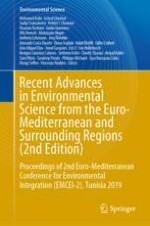2021 | Book
Recent Advances in Environmental Science from the Euro-Mediterranean and Surrounding Regions (2nd Edition)
Proceedings of 2nd Euro-Mediterranean Conference for Environmental Integration (EMCEI-2), Tunisia 2019
Editors: Ph.D. Mohamed Ksibi, Achraf Ghorbal, Dr. Sudip Chakraborty, Helder I. Chaminé, Dr. Maurizio Barbieri, Prof. Giulia Guerriero, Dr. Olfa Hentati, Prof. Dr. Abdelazim Negm, Anthony Lehmann, Dr. Jörg Römbke, Prof. Dr. Armando Costa Duarte, Dr. Elena Xoplaki, Dr. Nabil Khélifi, Prof. Dr. Gilles Colinet, João Miguel Dias, Imed Gargouri, Dr. Eric D. Van Hullebusch, Benigno Sánchez Cabrero, Prof. Settimio Ferlisi, Chedly Tizaoui, Amjad Kallel, Dr. Dr. Sami Rtimi, Dr. Sandeep Panda, Philippe Michaud, Jaya Narayana Sahu, Mongi Seffen, Assoc. Prof. Vincenzo Naddeo
Publisher: Springer International Publishing
Book Series : Environmental Science and Engineering
